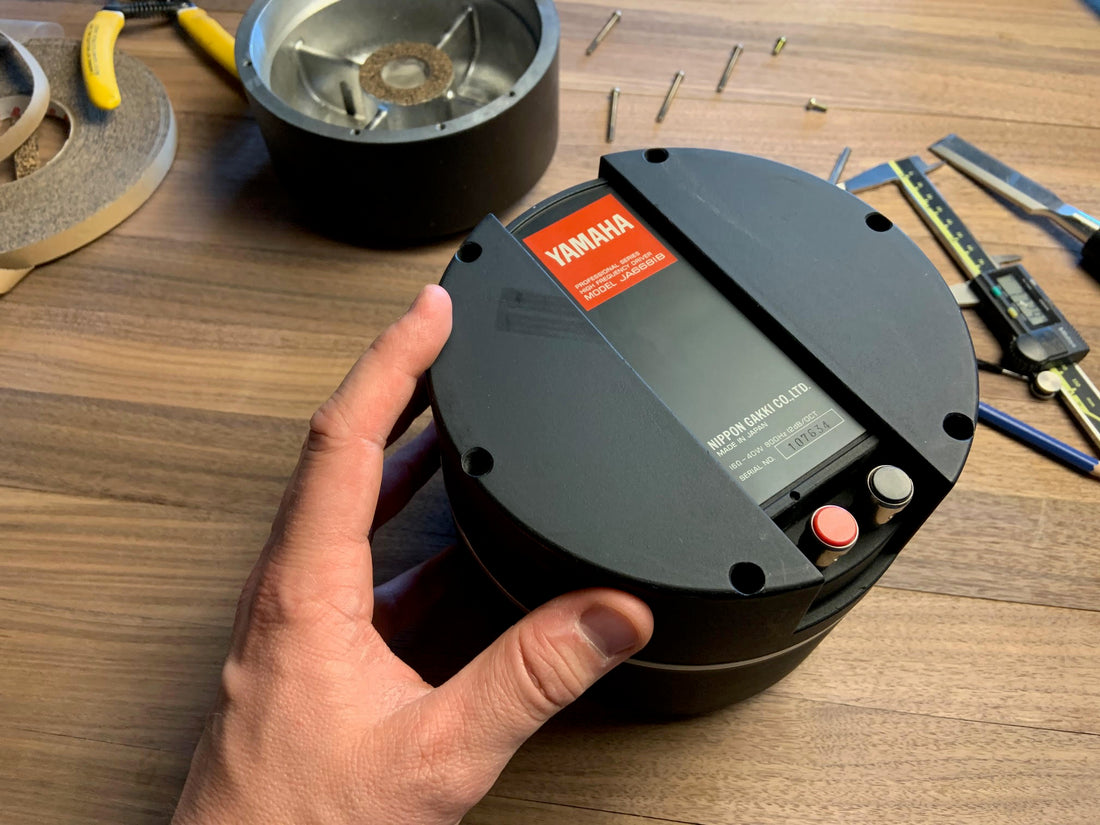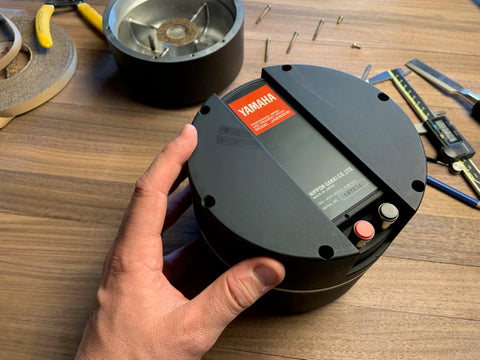I this blog post I look closely at the Yamaha JA6681B compression driver. This driver is similar in size to the Altec 288 and has the following specifications.

This compression driver uses a unique suspension system. The surround is comprised of 15 tiny copper beryllium arms that flex to allow diaphragm movement. Between the arms are open space to allow air movement.
The driver uses a 1" to 1.4" conical adapter which can be removed. This is not technically how the driver was intended to be used, however using this 'modified' driver on a 1" throat horn allows for a more optimal flare geometry in the throat. I'm not a fan of conical adapters and I avoid using them if at all possible.
To test I used my prototype ES-600 Biradial horn with a 1" throat.
Disassembly Procedure
Once the rear cover was removed I then removed two screws holding the throat adapter.


The phase plug comes right up to the throat of the driver now.


Yamaha S-6115-H shown dissassembled and mounted to my prototype ES-600 Biradial with wood screws using the original holes used to mount the Yamaha's throat adapter.

Below is the front of the horn for reference. I only tested the HF horn and used the bass cabinet below simply as a support stand. But at least my measurements would show the effect of the bass cabinet below (if any).

To reassemble the diaphragm back onto the driver I decided to run a 400Hz sine tone with my microphone placed near the diaphragm. I took it a step further and used the spectrum analyzer within ARTA to show me harmonic distortion + noise in real time as I tightened the screws. When I first remounted the diaphragm I was getting around 6% distortion. I then decided to rotated the diaphragm to the next set of holes. This reduced the distortion to 4%. I then rotated it again another set of holes and it reduced to 2%. Finally I removed all the screws and started securing the screws one by one while observing the spectrum analyzers real time distortion. I found that by adding only the four screws reduced distortion to 0.50%. If I added the other two screws (see my fingers in the picture below) then distortion would increase as soon as they started to snug down. I thought I would mention this procedure in case anybody suspects they have a voice coil rub issue. After I finished this procedure the driver sounded noticeable better. The 400Hz sine tone had a purity to it that it did not have when I first attempted to re-installed the diaphragm.

Measurements
The frequency response shows excellent linearity with a -3dB down point of around 11kHz. There is a +3dB hum centered around 1.4kHz. This could be taken care of with a notch filter if it was found to be objectionable. The low frequency extension of 600Hz matches the Fc of the this horn (600Hz).

For comparison the TAD TD-2001 is shown below on the same horn.

The Yamaha digs a little deeper into the low frequency however it doesn't have the same high frequency extension as the TAD. However one thing to note is that the Yamaha has a similarly smooth frequency response! This is quite an achievement! Considering the cost difference between the two, the Yamaha is a viable alternative. At the time of writing, this Yamaha is available on the used market for $650 USD per pair.
Burst Decay
Below is the burst decay response. This driver performs admirably with relatively clean decay. There is a very broad Q resonance low down at 10kHz, but it's audibility would be in question.

Below is the same chart as above except with the vertical scale reduced to 25dB. This is a more common scale factor to help with comparison against other published results.

Step Response
The step response shows a very fast rise time and very fast initial decay. The final tail of the decay is very subtle. A very good result!

Impedance Sweep
The impedance sweep shows a very low fundamental resonance of 300Hz! This is impressive! Note that I've removed the rear chamber for my testing. Above 300Hz the impedance remains extremely flat. For reference if any peaks show up in the impedance sweep this is always accompanied by resonances in the time domain. The high frequency breakup starts at 12kHz which also corresponds to the sharp drop in the frequency response. So the high frequency breakup (assuming that's what it is) is likely a high Q suck-out in the response and not a peak. I'd rather have a little less high frequency extension than a resonant mode peak that's clearly audible.
Harmonic Distortion
I get good results here with nothing of concern.

Intermodulation Distortion
Using a multitone signal at 90dB at 1 meter produced the following noise spectrum. Side bands are -70dB down at 8kHz. This is only 0.030%, the lowest I've measured. Admittedly I've only tested a few drivers so far!
For reference here the noise spectrum of my room.
Off-Axis Polar Frequency Response
I've shown this data in other posts and I will share it here for convenience. The polar map shows that this can indeed be used in a high quality 2-way providing wide, evenly controlled coverage from Fc-20kHz.
This concludes my testing of the Yamaha JA66181B. Grab a pair on the used market before somebody else does! These drivers were sent to me by a customer for testing. The customer was merely interested in how they would perform. I plan on sending the drivers back to him. I don't think he will be letting them go!






